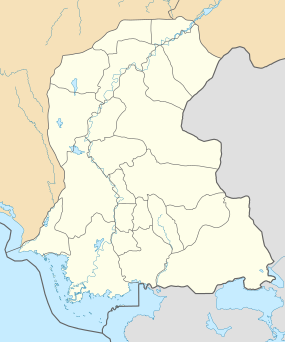Chanhudaro
| Alternate name | Chanhu daro |
|---|---|
| Location | Mullan Sandh, Sindh, Pakistan |
| Coordinates | 26°10′25″N 68°19′23″E / 26.17361°N 68.32306°ECoordinates: 26°10′25″N 68°19′23″E / 26.17361°N 68.32306°E |
| Type | Settlement |
| Area | 5 ha (12 acres) |
| History | |
| Founded | 40th century BC |
| Abandoned | 17th century BC |
| Periods | Regionalisation Era to Harappan 4 |
| Cultures | Indus Valley Civilization |
| Site notes | |
| Excavation dates | 1930, 1935–1936 |
| Archaeologists | Nani Gopal Majumdar, Ernest John Henry Mackay |
Chanhudaro (also Chanhu Daro) is an archaeological site belonging to the post-urban Jhukar phase of Indus valley civilization. The site is located 130 kilometers (81 mi) south of Mohenjo-daro, in Sindh, Pakistan. The settlement was inhabited between 4000 and 1700 BCE, and is considered to have been a centre for manufacturing carnelian beads. This site is a group of three low mounds that excavations has shown were parts of a single settlement, approximately 5 hectares in size.
Chanhudaro was first excavated by N. G. Majumdar in March, 1930 and again during winter field session of 1935-36 by the American School of Indic and Iranian Studies and the Museum of Fine Arts, Boston team led by Ernest John Henry Mackay. Prof. W. Norman Brown of the University of Pennsylvania was instrumental in enabling the funds for this project. After the independence of Pakistan, Mohammed Rafique Mughal also did exploratory work in the area.
Chanhudaro is one of the most important sites of Indus Civilization. More than 2500 sites belonging to Indus Civilization are identified so far and Chanhudaro is one of the bigger sites where lot of scope is identified for excavation. However, of late, excavations in this site have not been in progress leading to a decline in contributions from this site. It is situated in a desert area, but it is believed that the Sarasvati River used to flow near this site. Sarasvati river is believed to have dried up during 2nd millennium BC, causing the life at Chanhudaro and several hundreds of dwellings situated on the banks of Sarasvati to become very difficult. The people there probably had to abandon their dwelling places and it is thought that drying up of Sarasvati is one of the reasons for the decline of these dwellings, (cities and villages) which in turn contributed to the decline of Indus Civilization itself.
...
Wikipedia


